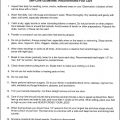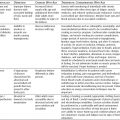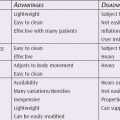PEARLS
❖ The primary reasons for consultation services in geriatrics are patient care, professional education, public relations, screening, and quality assurance.
❖ The benefits of geriatric consultation are the following:
- Decreased length of hospitalization and responsible use of expensive health care resources
- Increased use of rehabilitative services and identification of new diagnoses
- Improved patient care
- Greater access to educational resources
❖ Rehabilitation therapists may serve as consultants in nursing homes, senior centers, hospitals, rehabilitation centers, fitness centers, industrial settings, and home care. The consultant’s role will change in each setting.
❖ The steps in a successful consultation process are needs assessment, query, proposal, negotiation, implementation, and evaluation.
❖ The most important phase of the consultation process is the evaluation or outcome phase. This step can be as simple as checking patient satisfaction or as sophisticated as statistical analysis of postprogram scores.
❖ The major problems in aging research are sampling, participant recruitment, and design constraints.
❖ Evidence-based practice is crucial for the optimal care of older patients. Many components make up evidence-based care.
The consultant role is not new to physical or occupational therapy because rehabilitation professionals serve as consultants to other health care team members in daily treatment delivery. However, the therapist’s role as a consultant is new in the realm of geriatrics. Most literature on the subject of the consultant in geriatrics has been focused in the areas of medicine and nursing. Literature in the realm of physical therapy consultation is relatively recent, sparse, and evolving.
Literature on geriatric consultation states several reasons for its development.1 These reasons include patient care, professional education, public relations screening, and quality assurance. The major reasons for requesting geriatric consultation were medical management, discharge planning, evaluation and management of dementia, and failure to thrive.1 According to another early study, the major reasons for requesting consultation were geriatric evaluation (28%), assessing rehabilitation potential (27%), and mental status evaluation (3%).2
Several benefits of geriatric consultation have been enumerated in the literature. These benefits are as follows:
❖ Decreased length of hospitalization3
❖ Increased use of rehabilitation services4
❖ Improved patient care5
❖ Decreased use of expensive health care resources6
❖ Increased identification of new diagnoses7
❖ Provides a source of education8
The negative aspects of geriatric consultation are the following:
❖ Conflicts may arise among the disciplines when there is a “turf” battle over the overall management of the patient.
❖ Geriatric consultation can be time-consuming.3,8
❖ This type of consultation can also be costly.8
❖ Difficulty maintaining the team without identified leadership roles.3
The final introductory point on geriatric consultation is efficacy. The general literature reveals no definitive conclusions as to the efficacy of consultation. The literature is fraught with complications about the type of patient classically referred to a medical geriatric consultant. First, the frailer patients are more frequently referred and are more difficult to manage. Second, the recommendations of the consultant are often only partially followed.9–12 Even with the controversy in geriatric consultation, the potential benefit to the older person in different treatment settings outweighs the negative aspects cited. In addition, in this chapter, the benefits and pitfalls of geriatric research are examined as they relate to the use of evidence-based practice in any setting.
SETTINGS FOR CONSULTING
Nursing Homes
The variety of settings available to the rehabilitation consultant in geriatrics is limited only by the therapist’s imagination, but the major areas of consultation are nursing homes, home care, community senior centers, hospitals, rehabilitation centers, outpatient clinics, and industrial settings.13
In the nursing home, a therapist can work as a staff therapist and receive a regular salary with all the benefits, or he or she can contract. Contract basis in the nursing home can take many forms, the most common of which are the hourly, per patient, or direct bill. In the hourly arrangement, the therapist charges the nursing home for any hours spent in the facility, with the majority of time being spent in direct patient care. In addition, the therapist may set up restorative programs, provide in-service education, conduct screenings, and assist in quality assurance. The therapist is simply reimbursed on a time-spent basis.14
Per patient payment arrangement reimburses the therapist based on how many patients are seen. This can be a flat figure per patient or based on a percentage of charges. The percentage method can be further broken down into the percentage of charges billed and the percentage of charges received. It is obvious that it is more advantageous to the therapist to contract on a percentage-billed basis, whereas the nursing home would prefer to use the percentage received. The pros of the first situation are that the therapist does not have to wait for the money and is not dependent on the nursing home’s filing ability. In addition, the therapist does not risk a denied claim. The therapist who contracts on a percentage basis has several options in providing nonpatient care services. They can be included as part of the package on a gratis basis; the therapist can be reimbursed on a hourly basis for any time spent in presentation and preparation; or a flat fee can be assessed on a weekly, monthly, or yearly basis for these extra services.15,16
The final, most common method of consulting in a nursing home with direct patient care as the major emphasis is direct billing of the patient. In this situation, the therapist offers to treat any appropriate patients and to bill the respective insurance company. This form of consultation is riskier and more inundated with paperwork than the previously mentioned methods; however, it can prove to be the most lucrative.
Home Care
Consultation in home care is identical to the situation already described when the consultant subcontracts with an agency. In this situation, the therapist can be salaried, hourly, or per patient. In an even more independent situation, a therapist can hang up a shingle and treat patients in the home. The therapist will directly bill the patient and/or the insurance company.17 Health care costs following acute hospital care have been identified as a major contributor to regional variation in Medicare spending.18 The use of preoperative physical therapy was associated with a 29% decrease in the use of any post–acute care services. This association was sustained after adjusting for comorbidities, demographic characteristics, and procedural variables.18 The clinical relevance of this is that health care providers can use this methodology to achieve an integrative, cost-effective patient care pathway using preoperative physical therapy.
Senior Centers
Senior centers and retirement homes provide a creative way of consulting in the geriatric realm, and therapists can serve in several capacities. For example, they can conduct environmental assessments, develop and teach exercise classes, or provide screening programs. The financial arrangements for these types of programs can be quite varied. The consultant can offer the facility a menu of these activities with a cost-per-activity charge. Another alternative is an hourly arrangement to provide whatever services are needed. The consultant can also directly charge the participants. For example, a consultant may charge each exercise class of 10 participants $5 per session or $20 for 4 sessions. The consultant may also want to provide some of the services for free as a public relations effort for future programs.19
Hospitals, Rehabilitation Centers, and Outpatient Clinics
Hospital consulting is a new area of physical and occupational therapy; therefore, the therapist seeking hospital privileges is a relatively new and controversial topic.
The consultant in the hospital, rehabilitation center, and outpatient clinic can always contract to provide direct patient care on an hourly, per patient, or direct bill basis. He or she can also act to provide special assessment for older patients, which may take the form of a screening, such as an osteoporosis, balance, or foot evaluation. The consultant may also be called in to provide expert advice on how to improve the outcomes of therapy or to perform functional assessment specific for older persons (see Chapter 10 for functional assessment tools). In addition to providing these services in the hospital, rehabilitation, and outpatient settings, the consultant can provide continuing education and screening programs to the public as well as quality assurance expertise. The financial arrangement for this could take the form of an hourly contract, fee for service, or flat fee contract.
Industrial Settings
With increasing life expectancy, many older individuals choose to remain active in employment settings. In fact, many industrial entities actively recruit the older worker. As a result, industrial rehabilitation for an older population is an excellent platform for the consulting therapist. The consultant in a work-related setting can contract to do screening, functional capacity testing, ergonomic assessments and modifications, conditioning programs, and educational programs on health- and wellness-related topics for the older worker. Instruction in proper body mechanics for lifting and other repetitious activities can be implemented to prevent injury.
In all of these settings, the geriatric consultant may be asked to design a program where none has existed previously. This will require the consultant to create policy and procedure manuals, employee handbooks, and billing procedures and forms. In the opinion of the authors of this book, the best approach to this type of arrangement is to develop an hourly contract. A flat fee contract can also be used; however, this does not give the consultant the freedom to spend time on unforeseen complications that may arise in the process of designing a program.18–20
IDENTIFYING CONSULTANT ACTIVITIES
Screening Programs
Screening programs are one of the major activities of the geriatric consultant. They can be conducted in any of the settings listed as well as in a public setting (eg, shopping malls).20–22
Direct Patient Care
Therapists can provide part-time or full-time direct patient care as another type of activity, and it can be very creative. In many situations, the rehabilitation therapist conducts the initial evaluations and discharge evaluation, and the therapist assistant provides the hands-on treatment under the supervision of the physical therapist. Some therapists set up classes for providing care to similar patients in the hospital, nursing home, or community setting. The options for care in this setting are limitless.23,24 Nevertheless, the important components of this type of consulting are appropriate evaluation, progressive treatment strategies, and comprehensive discharge planning. Throughout this process, the therapist must provide appropriate documentation.
Quality Assurance and Chart Review
Rehabilitation therapists can also act in a consultative capacity to provide quality assurance and chart review assistance. To provide this type of service, the therapist should consult several references in this area. Several groups exist across the country that provide this type of service. However, if it can be done in-house or locally for less money and inconvenience, then the therapist is providing a worthwhile consultant service.22–28
THE CONSULTATION PROCESS
To execute a successful consultation program, a methodical and reproducible process should be followed. The steps in this process are as follows:
❖ Needs assessment
❖ Query
❖ Proposal
❖ Negotiation
❖ Implementation
❖ Evaluation
A needs assessment can be conducted simply or through a very sophisticated process. In its simplest form, a needs assessment is conducted either by asking people if they think a program would be beneficial or by observing the site. Increasing in sophistication, a needs assessment would be a random phone survey, a written survey to a specific audience, or tapping the data from a community or facility survey.
The query portion of the process entails asking detailed questions to assist in the design of the program. For example, if a posture screening program is to be developed, questions about the time of day, acceptable waiting time, price, expectations, and people and facilities available would be useful (Figure 20-1).
A proposal can be simple or sophisticated. A simple proposal would be a telephone call to the general manager of a community mall, with a discussion that included information on the therapist’s background. If space is available, the therapist should ask what the appropriate times are, about the available staff, and about additional expense requirements. A letter restating the terms can follow this up.

Figure 20-1. A sample query for the design of a program.
Stay updated, free articles. Join our Telegram channel

Full access? Get Clinical Tree








